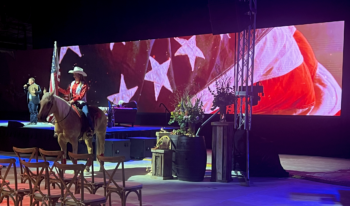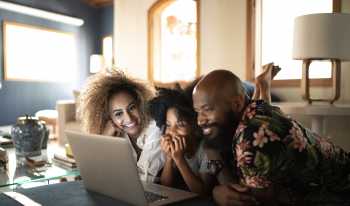It’s game day on the Clemson campus, but John and I are not there to tailgate. Instead, we got up a little early to beat the worst of the game day traffic to travel to the studio located in Clemson’s Madren Center. We like to arrive early. The studio and adjoining offices are all dark. The Clemson team is out and about, shooting game day footage, but the day before, they showed us where we could find the key to let ourselves in.
This is our fifth trip in a little over a year to capture interviews of Clemson donors, leaders, alumni, parents, and academics—and John and I feel like part of the family. It all started with an engagement to capture the stories of five donors on video, purely for stewardship purposes to show the donors respect by preserving their stories for posterity. These donors raved about their experience so much that Clemson invited us back to provide this stewardship experience for others.
Each day-long session consists of five interviews, each lasting about an hour. Occasionally, we might fit six interviews in a session, but it’s not something I like to do. It can be a pretty heavy lift mentally and sometimes emotionally to actively listen and engage. Mauria Brough, our president, helped develop our person-centered interview style which is designed to allow the interviewee to lead in determining what they want to share and how they would like to share it. Each interview resembles an in-depth conversation rather than merely a series questions and answers.
Prior to an interview, I use the interviewee’s bio as a guide to draft questions. Some of the questions are pre-set—for example, “How did you first become engaged with the organization?”—but some are tailored to the interviewee’s experiences and areas of expertise. I print them out to have them in hand during the interview to refer to occasionally, but the real reason for writing them is to get a general sense of the areas the interviewee might want to explore.
John retrieves the key to the studio from its hiding place and opens the door to the studio. We conducted interviews the previous day and ended work yesterday by setting up for today’s shoot. We also have our pre-interview rituals to go through. John likes to double check the lights and sound; I lay out the release form for our first interviewees to sign and put my questions, along with a handwritten thank-you note for them, on my chair.
“I think it’s right through here.”
I look up to see three people coming through the control room into the studio. I recognize the couple from the photo on their bio provided by the Clemson development team. I realize—also from the bio—that the third person is their son. Our first interviewees are early—they even managed to beat their development contact to the studio.
John and I warmly greet the arrivals and get them settled in. “Which chairs would we look best in?” the woman asks, referring to the chairs under the lights—one in Clemson orange and the other, Clemson purple. The couple has thoughtfully worn coordinating shades of gray, so I study their coloring. “I think you should sit in the purple chair, “I tell the woman. “You’ll look better in that chair, and your husband will look better in the orange.” We invite their son to sit on a tall stool off to the side so he can see the interview but be out of the shot.
Unless they work in television or as a social media influencer, our interviewees typically feel a little out of their element in front of a camera. Taking time to make sure they look their best helps them know they are in good hands. The wife notices her husband has a piece of hair that doesn’t want to lay right. I pull the hairspray and a brush out of our make-up kit. “Would you like to do the honors?” I ask his wife. She attends to the errant lock.
The kit also contains translucent powder to mattify a shiny complexion or bald pate, as is often the case, and tissues—lots of tissues. Interviewees are often surprised by emotions that well up and spill over when they are talking about their philanthropic passions. That reaction could be due to being under lights and already feeling a little nervous, but it could also be because we are taking the time to carefully listen to their story and ask them to reflect on their experiences—or combination of both. Many times, an interviewee will say, “That’s a great question—I’ve never thought about that.”
As John makes minor adjustments to the focus and sound, I let the interviewees know what to expect. “Everything you’ll talk about is from your perspective and experiences, so there are no right or wrong answers,” I say. “We’re just going to have a conversation, but unlike a normal conversation—we have the power of editing. If something doesn’t come out the way you’d like, just pause and start again.”
The couple relates the story of how their son was born with a condition that caused him to have an intellectual disability. “As his mother, I just wanted a place where he could belong,” the wife says. They found that place in ClemsonLIFE™—a program that offers a collegiate experience for students like their son. “We had a list of programs to check out. We visited Clemson first, and we didn’t bother to visit any of the others because we knew this was the place,” the husband explains. Their desire to provide and expand this experience for others like their son led them to be philanthropic. As they tell their story, I’m humbled—as I often am—by their pure desire to improve the lives of others.
“Well, how did your parents do?” John asks their son when the interview concludes.
“Great!” he emphatically replies.
“Our son has a great story, too,” the couple says. We want to hear it.
Turns out, he acted as a student manager for one of the Clemson athletic teams. He loved attending practice, and when things got a little tough—maybe in practice, maybe during a game—he was known for encouraging the players by telling them, “You’ve got this—it’s too easy!” The team loved it so much, they told him he should put it on a t-shirt, so that’s what he did. He connected with the local screenprinting shop to create a “too easy” t-shirt, the proceeds of which went toward the ClemsonLIFE™ program. John and I love that story so much, we place an order for our very own shirts after our work for the day wraps up.
Days later, a package containing our shirts arrives in the mail. I live in Iowa State Cyclone and Iowa Hawkeye country, so I definitely stand out in my Clemson orange. It serves as a reminder to me of the interview, of a son finding his place, and of a couples’ determination to express their love for humankind.


